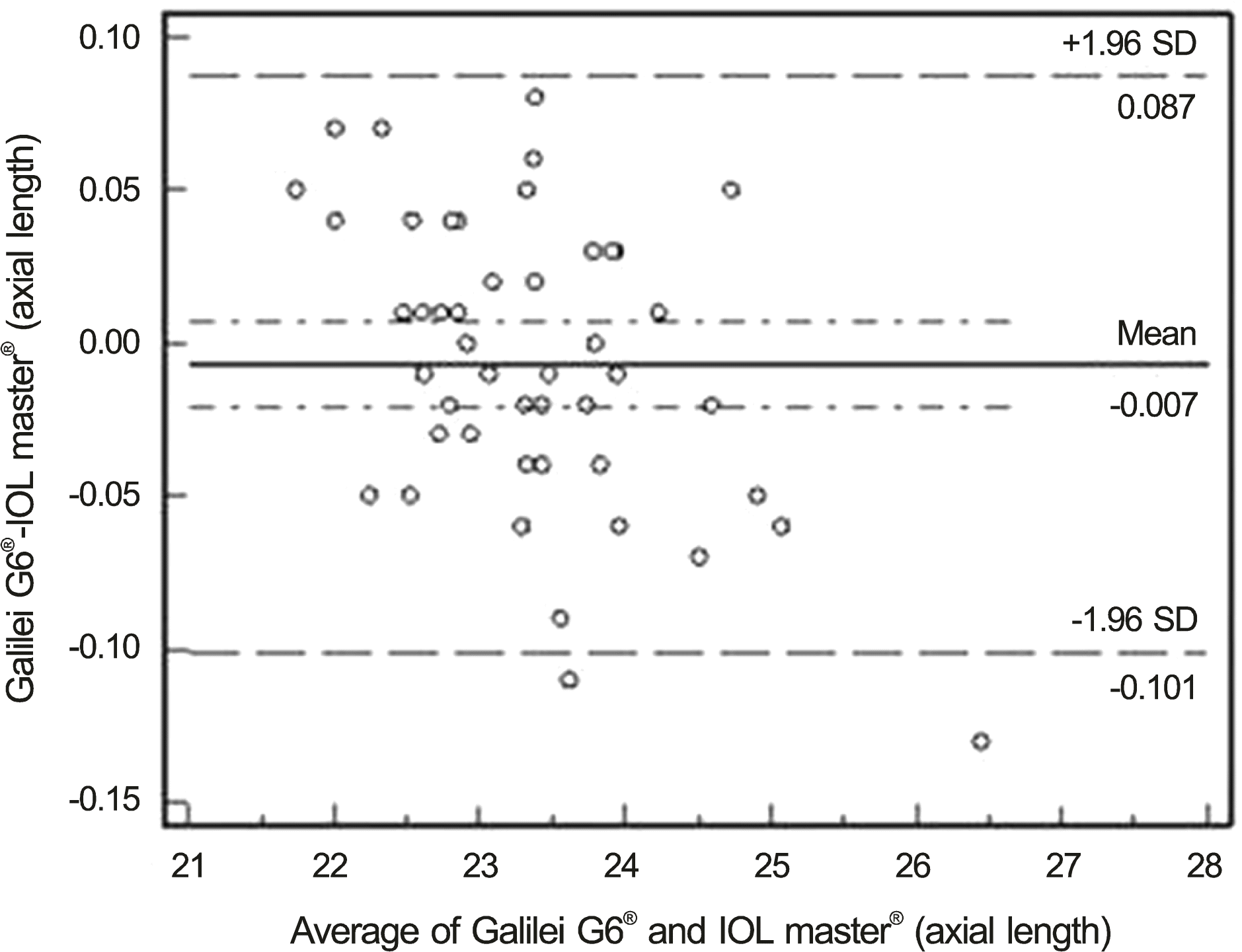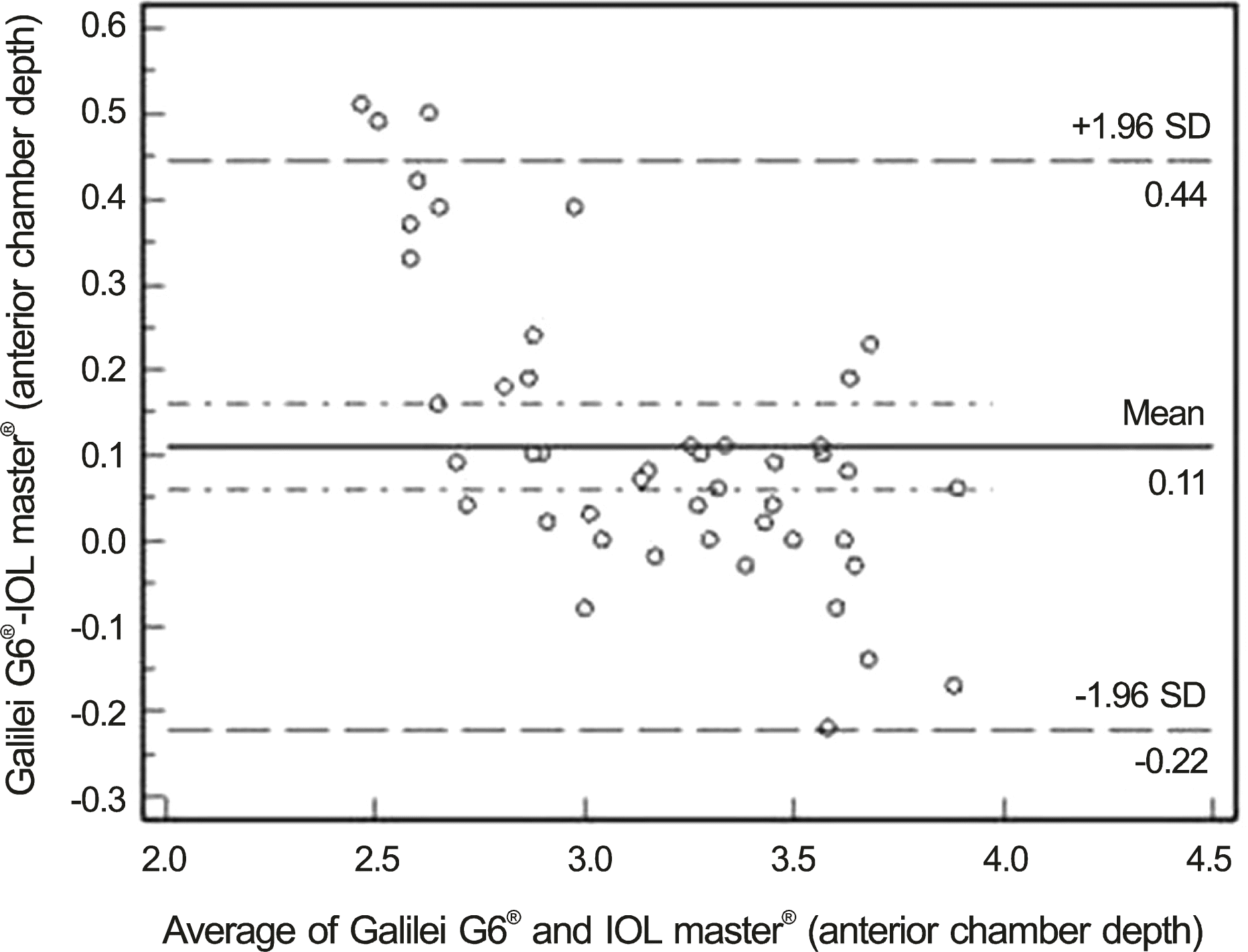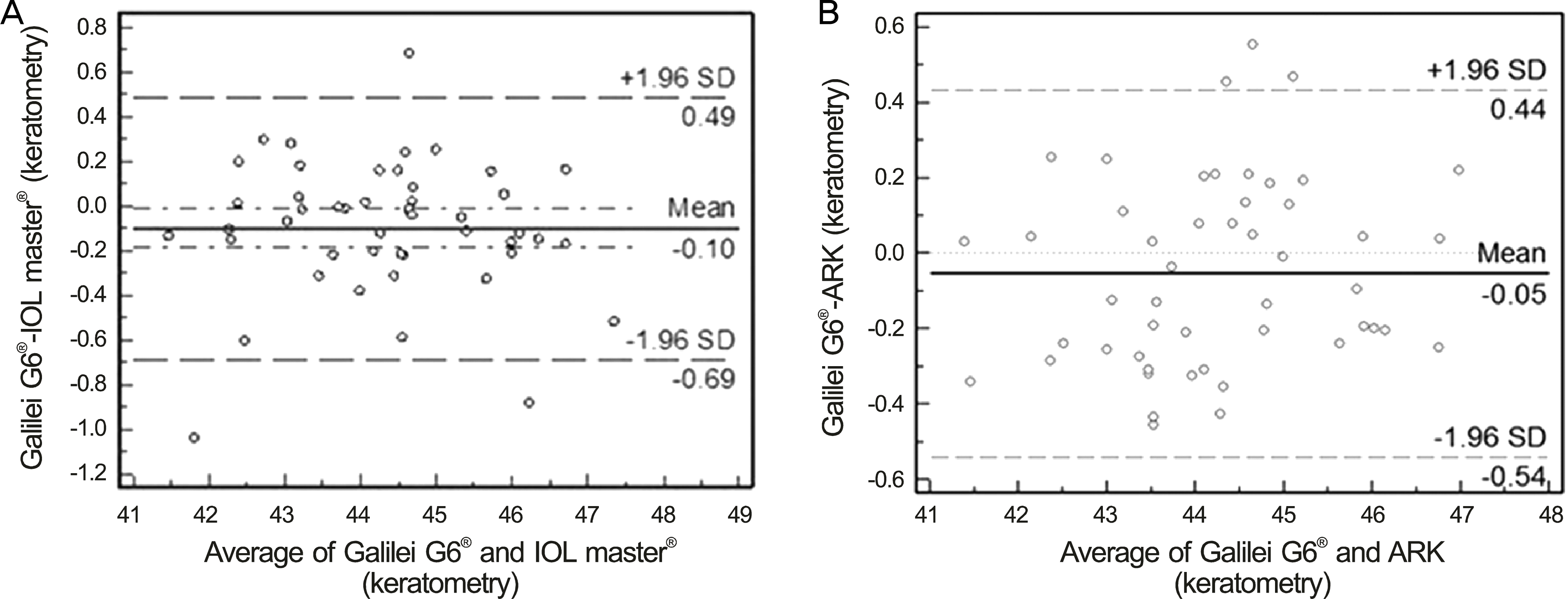초록
Purpose:
To compare the axial lengths, anterior chamber depths, and keratometric measurements and to predict postoperative refractions of Dual Scheimpflug analyzer Galilei G6® and intra ocular lens (IOL) Master®.
Methods:
A total of 50 eyes in 50 patients who received cataract surgery were included in the present study. The axial length, anterior chamber depth, and keratometry were measured using 2 types of partial coherence interferometries (Galilei G6® and IOL Master®). The SRK/T formula was used to calculate IOL power and the predictive error which subtracts predictive refraction from postoperative refraction was compared between the ocular biometry devices.
Results:
Axial lengths were 23.36 ± 0.80 mm and 23.36 ± 0.90 mm measured by Galilei G6® and IOL Master®, respectively. Axial length measured by Galilei G6® was not statistically significant compared with IOL Master® ( p = 0.321). The anterior chamber depth and keratometry were 3.22 ± 0.35 mm and 44.29 ± 1.40 D measured by Galilei G6® and 3.11 ± 0.46 mm and 44.39 ± 1.41 D measured by IOL Master®, respectively. The differences of anterior chamber depth and keratometry between the 2 devices were statistically significant ( p < 0.001 and p = 0.028, respectively). The mean absolute prediction errors were 0.45 ± 0.37 D and 0.49 ± 0.39 D in Galilei G6® and IOL Master®, respectively and was not statistically significantly different ( p = 0.423).
Go to : 
References
1. Olsen T. Sources of error in intraocular lens power calculation. J Cataract Refract Surg. 1992; 18:125–9.

2. Gimbel HV, Sun R. Accuracy and predictability of intraocular lens power calculation after laser in situ keratomileusis. J Cataract Refract Surg. 2001; 27:571–6.

3. Holzer MP, Mamusa M, Auffarth GU. Accuracy of a new partial coherence interferometry analyser for biometric measurements. Br J Ophthalmol. 2009; 93:807–10.

4. Hwang JS, Lee JH. Comparison of the IOL Master(R) and A-scan ultrasound: refractive results of 96 consecutive cases. J Korean Ophthalmol Soc. 2007; 48:27–32.
5. Lam AK, Chan R, Pang PC. The repeatability and accuracy of axial length and anterior chamber depth measurements from the IOLMaster. Ophthalmic Physiol Opt. 2001; 21:477–83.
6. Choi JH, Roh GH. The reproducibility and accuracy of biometry parameter measurement from IOL Master (R). J Korean Ophthalmol Soc. 2004; 45:1665–73.
7. Olsen T, Thorwest M. Calibration of axial length measurements with the Zeiss IOLMaster. J Cataract Refract Surg. 2005; 31:1345–50.

8. Shin JA, Chung SK. Comparison of the refractive results measured by ultrasound and partial coherence interferometers. J Korean Ophthalmol Soc. 2013; 54:723–7.

9. Patel RP, Pandit RT. Comparison of Anterior Chamber Depth Measurements from the Galilei Dual Scheimpflug Analyzer with IOLMaster. J Ophthalmol. 2012; 2012:430249.

10. Lopez de la Fuente C, Sanchez-Cano A, Segura F, Pinilla I. Comparison of anterior segment measurements obtained by three different devices in healthy eyes. Biomed Res Int. 2014; 2014:498080.

11. Santodomingo-Rubido J, Mallen EA, Gilmartin B, Wolffsohn JS. A new non-contact optical device for ocular biometry. Br J Ophthalmol. 2002; 86:458–62.

12. Kim SI, Kang SJ, Oh TH, et al. Accuracy of ocular biometry and postoperative refraction in cataract patients with AL-Scan(R). J Korean Ophthalmol Soc. 2013; 54:1688–93.
13. Shin JW, Seong MC, Kang MH, et al. Comparison of ocular biometry and postoperative refraction in cataract patients between Lenstar® and IOL Master®. J Korean Ophthalmol Soc. 2012; 53:833–8.
Go to : 
 | Figure 1.Bland-Altman plot of axial length between Galilei G6® and IOL master® (95% limits of agreement for axial length difference Galilei G6®-IOL master® [-0.101, 0.087]. IOL = intra ocular lens. |
 | Figure 2.Bland-Altman plot of anterior chamber depth between Galilei G6® and IOL master® (95% limits of agreement for axial length difference: Galilei G6®-IOL master® [-0.22, 0.44]). IOL = intra ocular lens. |
 | Figure 3.Bland-Altman plot of keratometry between Galilei G6® and IOL master® (A), and auto refractive keratometry (ARK) (B) (95% limits of agreement for axial length difference: Galilei G6®-IOL master® [-0.69, 0.49]; Galilei G6®-ARK [-0.54, 0.44]). IOL = intra ocular lens. |
Table 1.
Demographics and biometry measurements by Galilei G6®, IOL master®
| Galilei G6® | IOL master® | p-value* | |
|---|---|---|---|
| Age (years) | 69.2 ± 9.07 (51-92) | - | - |
| Sex (M/F) | 50 (20/30) | - | - |
| Cataract† | - | - | |
| Nuclear opacity | 3.6 ± 0.2 | ||
| Cortical opacity | 1.8 ± 0.1 | ||
| Posterior subcapsular | 0.6 ± 0.1 | ||
| AL (mm) | 23.36 ± 0.80 (21.77-26.39) | 23.36 ± 0.90 (21.71-26.52) | 0.321 |
| ACD (mm) | 3.22 ± 0.35 (2.72-3.92) | 3.11 ± 0.46 (2.21-3.97) | 0.000 |
| K (diopter) | 44.29 ± 1.40 (41.29-47.10) | 44.39 ± 1.41 (41.54-47.62) | 0.028 |
Table 2.
Comparison of absolute prediction error among Galilei G6®, IOL master®




 PDF
PDF ePub
ePub Citation
Citation Print
Print


 XML Download
XML Download